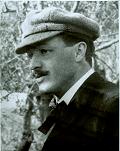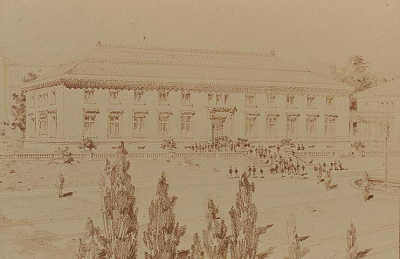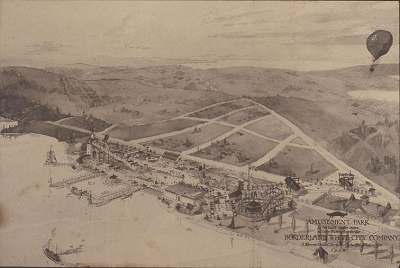 |
firm active: 1907-1921 minneapolis, minnesota :: chicago, illinois |
Biographical Notes: William Gray Purcell (1880-1965)
Biographical essay in Guide to the
William Gray Purcell Papers.
Copyright by Mark Hammons, 1985.
APPRENTICESHIP, 1903-1906
 Portrait of
William Gray Purcell, 1906
Portrait of
William Gray Purcell, 1906
Back home in Oak Park, Illinois, William Gray
Purcell went looking for a position from which he could learn the rudiments of
an active architectural practice. Surrounded once more by the progressive,
democratic architecture of the Midwest, the spirit of his quest toward an
indigenous, wholly American building art was freshly renewed. Although Purcell
considered applying to Frank Lloyd Wright, his father did not approve. Instead,
Purcell took a clerking position with Ezra E. Roberts, a stable and prosperous
architect of whom Charles A. Purcell thought well.
Respectable though Roberts was, his office was not very active. Purcell found
himself with time to lament the uninspiring contents of the architectural
periodicals and compose personal letters on the office typewriter. The situation
soon changed for the better, however, when Purcell attended a dinner party at
the Oak Park home of George Simpson, an old friend of his grandfather. Present
at the gathering was George Grant Elmslie, then the chief drafter for Louis
Sullivan. The two men liked one another immediately, not least because of their
shared interest in progressive architecture. When Purcell complained of his
situation with Roberts, Elmslie offered to secure Purcell a position in the
Sullivan office.
The five months from August to December 1903 that Purcell spent in the Sullivan
offices were the best possible fulfillment of his wish. In the rooms that the
Sullivan practice occupied high atop the tower of the great Auditorium Building,
completed by Adler & Sullivan in 1889, Purcell was exposed directly to the
originator and the principal practitioner of the architectural philosophy to he
was dedicated. His experiences in talking with Sullivan or observing his
interactions with other draftsmen as he moved among the drafting tables stayed
with Purcell as a source of inspiration for the rest of his life.
Sullivan, however, had entered the decline of his fortunes, and there was not a
great deal of work to be done in the office. Purcell drafted a lock plate and
doorknob for one project and also delineated a landscaping plan for his
employer's summer residence in Ocean Springs, Mississippi. With time available
to talk and study what work was passing through the office, Purcell and George
Elmslie became fast friends. Elmslie attempted to instruct Purcell in the fine
art of delineating the Sullivan ornament, and Purcell practiced on a design for
a public library that was later published in The Brickbuilder. By the end
of the year, though, it was clear there was insufficient work for Purcell.
 Presentation rendering California Hall, University of California Berkeley John Galen Howard, architect 1905 William Gray Purcell, Clerk of the Works |
 Design for a City Bank "Bank of Reno" Illustrated in Chicago Architectural Club Catalog (#18, 1905, plate 18) |
For his next employment, Purcell decided to venture to the West Coast by way of an extended journey through the southwestern United States. He eventually arrived at Los Angeles, where two of his aunts lived, and applied for work at the office of Myron Hunt, but there was no opening. On the recommendation of those with whom he interviewed, Purcell left southern California for San Francisco. Hired by John Galen Howard, Purcell became clerk of the works for the construction of California Hall, being built on the University of California campus at Berkeley. While he did not think much of the design of the structure, his stay in the area exposed Purcell to the work of Bernard Maybeck, who he came to admire. As could be expected with someone who had grown up around the play of light and water, he also noticed the pleasant manner in that bay windows on numerous houses reflected a functional response through house construction to the relationship between the hilly geography and the ocean views.
 Presentation rendering, aerial perspective view Amusement Park for the Borderland White City Company A. Warren Gould, architect William Gray Purcell, delineator |
In 1905 Purcell moved farther up the coast to Seattle, Washington, where he
worked for several months in the office of A. Warren Gould. Purcell's father,
who disliked the Pacific Northwest and was afraid of the effects of the weather
on the health of his son, offered to send him on a year long tour of Europe.
Accepting the offer, he contacted his former classmate, George Feick, Jr., and
two men agreed to meet in New York. Before leaving for the rendevouz, Purcell
spent ten days in Chicago that included a visit with George Elmslie. Elmslie
showed Purcell a magazine illustrating the work of a progressive Dutch
architect, H. P. Berlage, and encouraged him to meet the man if he could.
By April 1906 Purcell and Feick had crossed the ocean and were greeted upon
their landing at Naples, Italy, by the eruption of Mount Vesuvius, which
heightened their appreciation of visiting the ruins of Pompei. After seeing the
sights of Florence and Venice, they traveled across Greece to Constantinople and
by June had returned to western Europe. Although appreciative of the
architectural relics that surrounded him, Purcell was also keen to seek out the
best contemporary design as well. He remembered the suggestion made by Elmslie
and stopped in Holland to visit the architect Berlage, who received him warmly
and the two established a longlasting friendship. Although short of cash Purcell
was also successful in his efforts to reach Scandinavia, where he met
progressive architects Ferdinand Boberg and M. Nyrop. These contacts added
to his growing desire to commence his own work and shortly after returning to
the United States, Purcell moved to Minneapolis, Minnesota, to open an office in
partnership with George Feick, Jr.